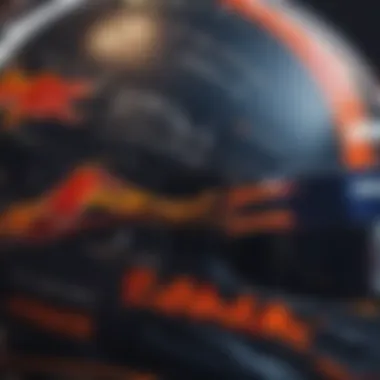Max Verstappen's Signed Helmet and Its Cultural Impact


Intro
Max Verstappen's signed helmet stands as a symbol of not just a personal connection between the driver and his fans, but also reflects broader themes within the motorsports culture. In an industry steeped in tradition and intense competition, the significance of such memorabilia extends beyond mere collectibles. It encapsulates the relationship between athletes and the items they use, revealing insights into the psychology of fans and collectors alike.
Sports memorabilia, especially in motorsports, has evolved dramatically over the years. Items like signed helmets have transitioned from simple keepsakes to coveted collector's items, influencing market dynamics and fan engagement in ways that are both fascinating and complex. This piece delves into the various facets of this phenomenon, aiming to unpack the significance of Verstappen's signed helmet while examining the intricate interplay of sport, culture, and commerce.
From the deep emotional attachment fans have with their favorite drivers to the economic implications of collecting signed items, each aspect tells a part of the story. By understanding these dynamics, one can appreciate not only the value of Verstappen's helmet but also its role in shaping the interaction between motorsports and its passionate community.
Prelude to Max Verstappen
Max Verstappen has emerged as a formidable figure in the world of motorsports. His achievements in Formula 1 have redefined what it means to be a young driver in a high-stakes environment. Understanding Verstappen's journey and significance not only sheds light on his personal brand but also the broader culture of motorsport fandom.
Biography and Early Career
Born on September 30, 1997, in Hasselt, Belgium, Verstappen comes from a lineage of racing. His father, Jos Verstappen, was a former F1 driver. Max was introduced to the sport at an early age, showing exceptional talent in karting. His competitive edge was evident; he began competing in various karting championships across Europe from just seven years old. By the age of 16, he made a historic debut in Formula 1 with Scuderia Toro Rosso, becoming the youngest driver to start a race. This early entry allowed him to rapidly accumulate experience, setting the stage for his rise.
Rise to Fame
Verstappen's ascent to fame can be traced through a series of remarkable performances. His first significant victory came at the 2016 Spanish Grand Prix, where he became the youngest winner of a Formula 1 race at just 18 years old. His aggressive driving style and fearless tactics quickly drew the attention of fans and critics alike, marking him as a standout talent.
The transition to Red Bull Racing further solidified his reputation. Under the guidance of the team, Verstappen honed his skills, consistently finishing on the podium in multiple races. His success is not just about victories; it also reflects a deeper connection with his audience, fostering an unparalleled level of fan engagement. The evolution of his brand, particularly embodied in items such as his signed helmet, highlights his cultural significance in motorsports.
Understanding Signed Helmets
Signed helmets have woven themselves into the fabric of motorsports culture. They encapsulate more than just an athlete's persona; they represent achievement, passion, and a connection between the driver and the fans. In this context, understanding signed helmets is crucial for appreciating the broader significance they hold within motorsports.
The Concept of Signed Memorabilia
Signed memorabilia, particularly helmets, serves as tokens of a pivotal moment in an athlete's career. For fans, acquiring a signed helmet goes beyond mere ownership; it provides a sense of closeness to the sporting world. Each signature transforms a standard helmet into a unique artifact, steeped in history and emotion.
Collecting signed items, especially helmets, has grown as a cultural phenomenon. Fans often cherish these items as symbols of loyalty and admiration. The value of signed memorabilia can surge dramatically, driven by the popularity of the athlete and their milestones. In Verstappen's case, the excitement surrounding his career amplifies the desirability of his signed helmets.
Psychology Behind Collecting
The motivations behind collecting signed helmets are deeply psychological. Fans invest in signed helmets not merely as decorations, but as pieces of their sporting identity. The value attached to these items can be viewed through the lens of social connection. When fans display a signed helmet, they effectively communicate their appreciation for the athlete and the sport.
Emotional investment often dictates the desire to collect. For many, a signed helmet can invoke memories of races, victories, or even personal milestones tied to a particular race. This emotional connection adds profound depth to the concept of collecting.


To summarize, understanding signed helmets enriches the dialogue about memorabilia culture in motorsports. Signed items like Max Verstappen's helmet encapsulate a unique interaction between athletes and fans, bridging the gap between competition and personal connection.
Max Verstappen's Helmet Design
Max Verstappen's helmet design holds significant value in the context of motorsports. It is more than just protective gear; it embodies the personality of the driver and resonates with fans around the world. The helmet's design reflects the individuality of Verstappen while also serving as a powerful branding tool. This section will delve into the distinctive features and personalization of his helmet, as well as the aesthetic role it plays in attracting fans.
Distinctive Features and Personalization
Max Verstappen’s helmet is known for its unique and eye-catching design. One notable aspect is the vibrant colors used, which often include shades of orange, red, and blue. These colors are deeply connected to Verstappen’s Dutch heritage and personal branding. The use of the number 33, his racing number, is also integrated effectively into the design.
Moreover, personalization is a key component of Verstappen's helmet. Each season often sees slight modifications and updates that reflect significant moments or milestones in his career. Fans admire this thoughtful approach to design, as it allows them to connect with the athlete’s journey. Collectors often seek these specific designs, as they symbolize particular achievements or races, further enhancing the helmet's value.
The Role of Aesthetic in Fan Attraction
The aesthetic appeal of a racing helmet significantly influences fan engagement. For many fans, seeing a driver’s distinctive helmet design as they race can evoke strong emotions and sense of belonging. Max Verstappen's helmet is no exception. The bold design captures attention on the track, creating a visual connection between the driver and the spectators.
Helmets serve as canvases that can convey messages, embody passion, or even champion social causes. Fans are drawn to the visual identity of drivers; in Verstappen's case, his helmet represents a strong branding resonance. This attraction often transcends the races themselves, leading to merchandise sales that include replicas of Verstappen's helmet.
Furthermore, the aesthetic has practical implications. A well-designed helmet stands out visually during races, making it easier for fans to identify their favorite driver amid the fast-paced action. This visibility can amplify the connection between Verstappen and his fans, reinforcing a sense of community and loyalty.
"A driver's helmet can tell a story, capturing the essence of their career while appealing to the emotions of fans."
The Significance of the Signed Helmet
The signed helmet of Max Verstappen holds considerable significance in the landscape of motorsports. It represents a confluence of achievement, identity, and community. In essence, the signed helmet is not merely a piece of racing equipment; it embodies the spirit of competition and the dedication of an athlete who strives for excellence.
In motorsports culture, helmets are customarily seen as individual expressions of a driver's brand. Hence, Verstappen’s signed helmet stands as a testament to his success and personal journey. Fans equate the helmet with the driver’s triumphs on track, making it a symbol of accomplishment and recognition in a highly competitive sport. Furthermore, it serves as a tangible piece of history, capturing moments that fans wish to preserve and celebrate.
The importance of the signed helmet extends beyond the immediate context of motorsports. It bridges a connection between the athlete and the fan, fostering a budding culture of support and admiration. This connection highlights a unique relationship where fans feel invested in Verstappen's success, merging their pursuits with his journey in racing.
Symbol of Achievement
A signed helmet, specifically Verstappen’s, signifies a distinct form of achievement. Winning races is not only about the trophy or accolades; it's about the legacy and the stories that come paired with each victory. Each signature transforms the helmet from a protective gear item into a narrative artifact, one that reflects the struggles and victories a driver has experienced over their career.
Moreover, the act of signing a helmet solidifies an athlete's presence in fans' lives. For many, owning a piece of signed memorabilia from their favorite athlete is akin to possessing a shard of their success. Thus, a signed helmet can serve as inspiration for fans, symbolizing relentless perseverance and dedication.
Connection between Athlete and Fan


The signed helmet fosters a unique bond between Max Verstappen and his supporters. This relationship transcends traditional spectator dynamics, evolving into a more personal connection. When fans acquire a signed helmet, they cherish it not only for its monetary value but for its sentimental worth. It is a connection to the athlete who has impacted their lives, sometimes from a distance.
In today’s sports environment, social media plays a vital role in enhancing this bond. Athletes like Verstappen frequently interact with fans online, sharing insights into their lives and careers. When fans obtain a signed helmet, they feel part of that journey, creating a sense of belonging. This emotional element affects how fans engage with the sport and contribute to its community.
In essence, the significance of a signed helmet is rooted in its ability to crystallize the relationship between motorsport athletes and their ardent fans, blending achievement, community, and personal narratives into a singular experience.
Market Dynamics of Signed Helmets
Understanding the market dynamics of signed helmets is essential in recognizing their place within the motorsports culture. Signed helmets, especially those of prominent drivers like Max Verstappen, hold significant value not only as collectibles but also as symbols of fandom and nostalgia. The demand for these items often fluctuates based on numerous factors including context within the sport, driver popularity, and market trends.
Signed helmets generate excitement among fans and collectors. The value of memorabilia can rise dramatically following key sporting events, such as race victories or championships won, making timing a crucial element. This increasing interest benefits both collectors seeking unique items and drivers aiming to enhance their visibility and brand value. Additionally, the emotional connection that fans develop with their favorite athletes further elevates the desirability of signed items.
As the motorsport memorabilia market continues to evolve, the appreciation for signed helmets reflects broader trends in collectibles. From limited editions to personalized designs, the landscape offers diverse options tailored to varying preferences. Understanding these dynamics provides insight into how items like Verstappen's helmet become symbols of success and pride in the high-speed world of racing.
Trends in Memorabilia Pricing
Pricing in the memorabilia market, especially for items like signed helmets, is often driven by rarity and significance. Many collectors pay close attention to specific trends that influence how much a particular helmet may be worth. For instance, limited editions or helmets worn during high-profile races can fetch astounding prices at auctions and online platforms.
Recent trends also show an increase in prices for helmets that have unique features, such as specific paint jobs or designs that represent milestones in a driver's career. A balanced mixture of exclusivity and emotional resonance often dictates the market value.
Another important consideration is the provenance of the helmet. Items with a well-documented history of ownership and significant events typically rise in value. Collectors often seek assurance of authenticity, which enhances trust and willingness to invest.
Auction and Collector Markets
The auction environment plays a pivotal role in defining the collector's market for signed helmets. Renowned auction houses such as Bonhams and RM Sotheby's frequently feature high-profile motorsport memorabilia, enabling enthusiasts to bid on rare pieces. Auctions create a platform where passionate buyers converge, often resulting in unexpected bidding wars that can drive prices beyond initial estimates.
Collector markets are also influenced by niche communities, particularly online forums and social media. Platforms like Reddit and Facebook have groups dedicated to motorsport memorabilia, where enthusiasts share information and trade items. These communities significantly impact the perception and value of signed helmets.
In summary, the dynamics of the market for signed helmets reflect a complex interplay of buyer interest, rarity, and emotional connections to racers. As interest grows, driven in part by social media and events, the future of signed helmets looks bright, marking their significance in motorsports culture.
Impact on Verstappen's Brand Value
Max Verstappen's signed helmet holds a significant place not just as a piece of memorabilia, but as a crucial component of his overall brand value in the motorsports ecosystem. This influence extends to various realms, encompassing endorsements, sponsorships, and media presence. To understand the impact fully, one must explore how these elements interconnect and affect Verstappen's marketability and appeal.
Endorsements and Sponsorships
Endorsements form a vital pillar of any athlete's brand. For Verstappen, his signed helmet symbolizes the success and achievements that sponsors wish to be associated with. Companies such as Red Bull Racing, which has had a longstanding partnership with him, benefit from his image as a young and talented athlete. This association lends credibility and prestige to their products.


When Verstappen wins races or achieves notable milestones, the visibility of his signed helmets increases, leading to a rise in endorsements. It creates a positive reinforcement cycle for brands involved.
- Increased Brand Value: Companies are willing to invest in Verstappen because his success translates to their marketing goals. A signed helmet is more than a collectible; it is an emblem of that success.
- Influence on Consumer Choices: Fans often emulate their favorite drivers, and having memorabilia, especially signed items, can influence purchasing behavior.
- Long-Term Relationships: Successful partnerships often result in long-lasting relationships that benefit both the athlete and the company involved.
Public Relations and Media Presence
Public relations play a crucial role in shaping an athlete's image. Verstappen's signed helmet acts as a conduit for his public persona. The media covers racing events extensively, and Verstappen, being a standout driver, garners significant attention. When a signed helmet is featured in a news story or promotional material, it elevates his brand recognition.
- Media Coverage: The more a helmet appears in media, the stronger its association with Verstappen becomes. This leads to increased interest among fans and collectors alike.
- Social Media Representation: Platforms like Facebook and Reddit amplify discussions around Verstappen and his memorabilia, including signed helmets. Fans showcase their collections, further embedding the helmet into the cultural fabric of motorsports.
- Crisis Management: In times of controversy, a strong public relations strategy can help steer the narrative. A signed helmet can serve as a reminder of Verstappen's achievements, reinforcing his image positively.
"A signed helmet is not just a token; it's a narrative of success, struggle, and connection, vital for both the athlete and the brands that support him."
Cultural Implications
Understanding the cultural implications of Max Verstappen's signed helmet goes beyond mere appreciation of a collectible. It embodies a larger narrative within motorsports culture, bridging the gap between athletes and their fans. Signed helmets serve as tangible connections to high-stakes races, representing moments of triumph and perseverance. The significance of this memorabilia extends into realms of identity, community, and commerce, making it a rich subject for exploration.
Merchandising in Modern Sports
The merchandising landscape in modern sports has evolved significantly, and Max Verstappen's helmet is an example of this trend. In today’s market, items such as signed helmets are not just kept as personal treasures; they have become valuable assets in the realm of merchandising.
- Demand and Supply Side: The demand for unique items that tell a story is ever-growing. Fans are eager to possess a piece of their idol’s journey. As a result, manufacturers and brands capitalize on this desire to create limited edition products, boosting value and exclusivity.
- Collaborative Marketing: Partnerships between drivers, teams, and merchandise companies enhance visibility and desirability of items. Verstappen’s helmet becomes a focal point, allowing brands to tap into his fanbase effectively.
- Cultural Connection: A signed helmet does more than serve as a piece of merchandise; it symbolizes an emotional connection to the sport. Fans often display these items prominently, reinforcing their identity as part of a larger community.
This interplay between fandom and merchandising not only fuels the collector's market but also helps in promoting the sport, broadening its appeal.
Role of Social Media in Popularization
Social media plays a critical role in amplifying the interest surrounding Max Verstappen’s signed helmet. Its influence on pop culture is profound and multi-faceted.
- Immediate Exposure: Platforms like Instagram and Twitter provide instant exposure. Fans share their collections, recount stories, and connect with other enthusiasts. This online community fosters a sense of belonging.
- Influencer Impact: Influencers and motorsport personalities often showcase signed memorabilia. Their endorsement can significantly increase interest and demand.
- Interactive Engagement: Social media facilitates direct interaction between athletes and fans. Verstappen might share behind-the-scenes content or stories related to his helmet, increasing its allure.
“The popularity of signed helmets among fans illustrates the strong ties between athletes and supporters in the digital age.”
Epilogue
The conclusion synthesizes the discussions about Max Verstappen's signed helmet and its multifaceted role in motorsports culture. This iconic piece of memorabilia is not merely an object; rather, it encapsulates the essence of fan engagement, the athlete's legacy, and the commercial activities surrounding sports collectibles.
Reflection on the Value of Memorabilia
The value of memorabilia like Verstappen's signed helmet extends far beyond monetary worth. This helmet symbolizes a tangible connection to the sport, representing moments of achievement and memorable races. For fans, it serves as a reminder of their loyalty and passion. Collecting such items can enhance one’s identity as a motorsport enthusiast. Furthermore, the significance is layered; each autograph represents a personal story of triumph, struggle, and dedication. As fans acquire these pieces, they weave themselves into the larger narrative of motorsports history.
Future of Signed Items in Sports
The future of signed items in sports appears promising. Collectors are increasingly valuing items not only for their aesthetic and nostalgic appeal but also for investment potentials. With digital platforms growing, purchasing, selling, and displaying memorabilia is more accessible than ever. Additionally, as athletes continue to cultivate their brands and engage with fans, the demand for unique collectibles, including signed helmets, will likely increase. Thus, signed items may become even more integral to the identity of sports fandom, serving as both a connection to the sport and as a financial asset for future generations.







